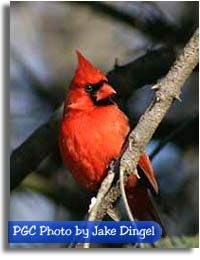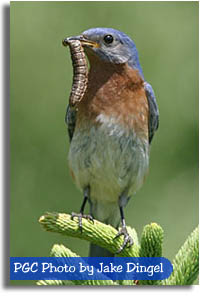|
|
By Joe Kosack
Wildlife Conservation Education Specialist
Pennsylvania Game Commission
|
|
 Harrisburg,
PA - Many Pennsylvanians are interested in attracting wild birds to
their yards. But when they head to the store to buy a birdfeeder or simply
birdseed, uncertainty and inexperience - even sticker shock - replace their
desire to do something more for songbirds. Harrisburg,
PA - Many Pennsylvanians are interested in attracting wild birds to
their yards. But when they head to the store to buy a birdfeeder or simply
birdseed, uncertainty and inexperience - even sticker shock - replace their
desire to do something more for songbirds.
Getting involved in backyard conservation, however, doesn't have to be a
challenge, frustrating or expensive. But if you're inexperienced, and/or
know very little about birds, there are some things you can do to improve
your success and make a difference for birds.
There are varying degrees of involvement in birdfeeding and providing for
birds. Your effort can be as simple as tossing a few handfuls of sunflower
seeds on the ground or buying special blends of seeds and using a variety
of feeders to attract seed- and insect-eating birds.
Backyard plantings are incredibly beneficial to songbirds, but since it's
the middle of winter, aren't exactly a timely pursuit. However, it's not
too early to begin thinking about what you can do to make your yard more
attractive to songbirds.
|
"Winter is a good time to get
out the seed and garden catalogues to plan your spring plantings," noted
Doug Gross, Pennsylvania Game Commission ornithologist. "When it comes to
attracting feathered wildlife, providing food, water and cover are always
guaranteed winners. But remember, almost any endeavor that provides cover,
increases habitat diversity, or even a water source, will be recognized and
utilized by songbirds. Certain plantings - shrubs, trees, groundcover, etc.
- will greater appeal to some species than others.
"Berry-producing shrubs and trees are particularly attractive to many
species, including cedar waxwings, American robins and eastern bluebirds.
Virtually all winter birds eagerly seek out wild berries and fruits, even
chickadees, cardinals and sparrows, birds that people commonly recognize
only as seed-eaters. Even ruffed grouse like winterberries and staghorn
sumac berries. Cardinals and blue jays gobble up dried grapes from arbors
as long as they last. A bird enthusiast can 'cheat' a little by offering
raisins at feeders; a favorite of lively Carolina wrens. Garden flowers
also can benefit birds, as finches feed on the dried seeds of zinnias,
marigolds, coneflowers, and, of course, sunflowers."
 Evergreen
shrubs and trees provide the cover and thermal protection birds seek on a
cold or windy day. The birds that visit your feeder in the day likely slip
into a juniper, spruce or Douglas fir near your house all night. Many
ground-foraging birds like the protection of a shrub overhead where they
scratch the ground for food. It gives songbirds such as the white-throated
sparrow protection from being attacked by a Cooper's or sharp-shinned hawk
while foraging. Evergreen
shrubs and trees provide the cover and thermal protection birds seek on a
cold or windy day. The birds that visit your feeder in the day likely slip
into a juniper, spruce or Douglas fir near your house all night. Many
ground-foraging birds like the protection of a shrub overhead where they
scratch the ground for food. It gives songbirds such as the white-throated
sparrow protection from being attacked by a Cooper's or sharp-shinned hawk
while foraging.
"There's no secret to being successful at attracting birds to your yard,"
noted Dan Brauning, Pennsylvania Game Commission Wildlife Diversity Section
supervisor. "There is not a backyard in Pennsylvania in which a variety of
birds don't visit or pass through. So the challenge - and typically it
really isn't much of one - is to hold them there. Equipped with feeders and
the right seeds and/or suet, your yard will pull in birds. |
"Weather and the comforting
cover provided by nearby trees and shrubs often will influence the
frequency and number of birds at your feeders. But if you have what they
want, they'll sit and wait in a nearby tree or forsythia bush until an
opening appears at the feeder. Wild birds are opportunists that rarely pass
up a table that is set."
Setting the table for birds depends upon what species you'd like to
attract. Contrary to popular opinion, there is no universal seed mix that
attracts everything. Some seed mixes include less-attractive seeds, such as
milo, wheat and hulled oats, which many birds have a tendency to pass over.
Black-oil sunflower seeds are the best seed on the market for attracting
the widest variety of songbirds. Other good offerings include: striped
sunflower, peanut chucks, hearts or kernels, white or red proso millet, and
niger thistle.
Setting up a smorgasbord of seeds and suet will lead to relatively nonstop
bird action during daylight hours in your backyard. Feeders filled with
black-oil sunflower, proso millet, peanut chunks or hearts and niger
thistle will create a stir, and that commotion will pull in other birds,
especially as migrants begin to start north in early spring. If you add a
couple of suet feeders to the line-up, you'll pull in woodpeckers, which
also are fascinating to watch. And if you're lucky, maybe a strikingly
handsome red-headed or pileated woodpecker will drop by. Pileated
woodpeckers are attracted to trees with large trunks and decomposing tree
stumps. |
"The power of food to draw
songbirds in winter, especially when there's a crusted snow or icing, is
remarkable," emphasized Brauning. "That magnetism is directly related to
the fact that many small birds can't go more than a few days without food,
given their high metabolic rates and inability to store energy reserves in
their bodies. It's a physiological compromise that keeps birds
flight-ready, but it forces them to forage almost incessantly for food."
Hanging and elevated bin birdfeeders are used primarily by small songbirds,
such as finches, titmice and chickadees. Platform and fly-through feeders,
which are the most accessible feeders, will attract the widest variety of
seed-eating birds, including ground feeders such as cardinals, mourning
doves and dark-eyed juncos. Wire cage suet feeders will lure woodpeckers,
nuthatches, titmice and chickadees. Corn ear spikes will attract
red-bellied woodpeckers, blue jays, crows and, of course, red, gray and
flying squirrels.
Feeder placement is critically important to bird health and viewing
success. The chief concern when placing a bird feeder is locating it at
least 20 feet away from any windows to avoid bird collisions. Millions of
birds die annually throughout the United States when they crash into
windows. The collisions are directly related to birds spooked from feeders
placed too close to windows and the inability of birds to detect windows.
If you would like a front-row seat for watching birds at your feeder,
ornithologist Daniel Klem, a professor at Mulhenberg College recommends
placing a feeder within inches of a window. Doing so, he reasons, will
reduce their chances of hitting the window with great force when flushed
from a feeder.
People who feed birds - particularly in urban and suburban areas - are
encouraged to continue feeding through early spring, because birds can and
do become dependent on feeders where there are few alternative food
sources. Feeders are increasingly important to birds as winter progresses
and the availability of natural foods declines. They also are critically
important whenever deep or crusted snow or icing separates birds from
natural foods, given their almost daily need for provisions.
During periods of deep snow, birds flock to feeders because a meal can be
obtained there with minimal effort. It's a great time for a new birdwatcher
to add to his or her growing checklist of species seen, as well as a
satisfying experience to see your feeding efforts making a difference for
birds threatened by bad weather.
People who feed birds also are advised that their feeders can be a magnet
for more than just songbirds. In addition to squirrels, feeders also may
attract anything from mice to black bears, as well as predators such as
hawks and cats. If a bear begins frequenting your yard, it's usually better
- and less expensive - to pull your feeders for a couple of weeks, rather
than trying to match wits with the bear, which quickly can become an
unwelcomed daily visitor and quite destructive. Bears may show up at a
feeder at any time after early April once they emerge from winter dens.
Avoid storing your birdseed - and particularly black-oil sunflower - in
heated areas, because it commonly contains grain moth pupae cocoons and
they will hatch at a faster rate and escape into your heated structure.
Place the seed outside in a metal ashcan or waterproof container that
rodents, such as mice and squirrels, will not gnaw through. If the
container is air-tight, it also will reduce it powers of attraction to
bears. Bay leaves can be used as a natural repellent for grain moths.
Practicality and durability are more important that aesthetics when buying
a bird feeder. Remember, birds and the weather will hog up anything you
place in your yard, so don't buy something that can't withstand the
elements or daily bird activity. Feeders constructed with cedar and
containing plastic and/or glass panes can take considerable abuse. So, too,
can those made of metal with plastic or glass panes. Buyers should look for
well-constructed feeders with simple designs that are easy to load.
"Although it's fair to say that when buying feeders you get what you pay
for, it's also important to point out that you can buy more than the birds
need," Brauning said. "The market offers feeders for $100 to $200, and
others for $5 to $10. Quite frankly, the birds don't care whether the
feeder is expensive or inexpenseive, or whether you paid $20 a bag for
sunflower seeds or $15. They're there for the food. Everything else is a
statement of your personal preferences!"
Providing a water source also is an excellent way to attract birds to your
backyard. It plays on their natural tendency to visit streams, springs, and
pools in the winter according to Gross.
"Traditional birdbaths now can be equipped with heaters, even solar-powered
units, to keep them from freezing in winter," he explained. "The biggest
wildlife magnet you can add to your yard is a small pond, especially one
with running water. It will draw all kinds of birds in all seasons and
provide many hours of entertainment for outdoor-oriented families.
"You might even attract a rarity or out-of-season migrant with this
addition to your yard," Gross noted. "I have enjoyed seeing hermit thrushes
and robins at our backyard pond in deep winter with snow on the ground. The
water, wild berries, and cover drew them into our yard."
For more information on bird conservation and songbird natural history,
visit the Game Commission's website (www.pgc.state.pa.us)
and click on "Wildlife" in the left column. |
| |
|
| |
|
Please join us in our
Discussions forums with topics covering Wildlife Rehabilitation,
Birding, Backyard Wildlife and More.
|
| |
|
|
|